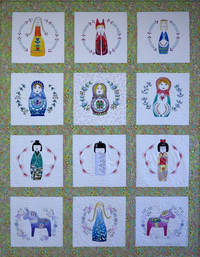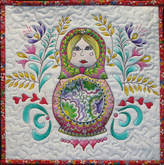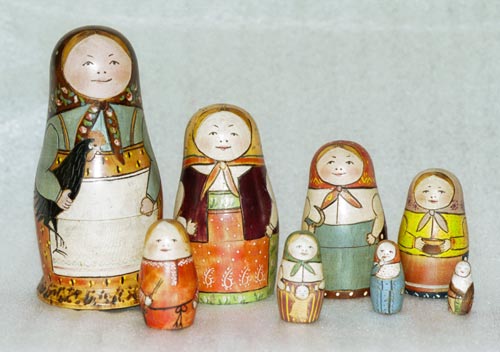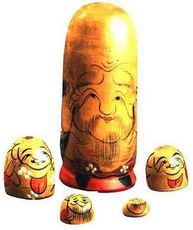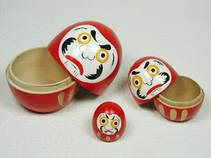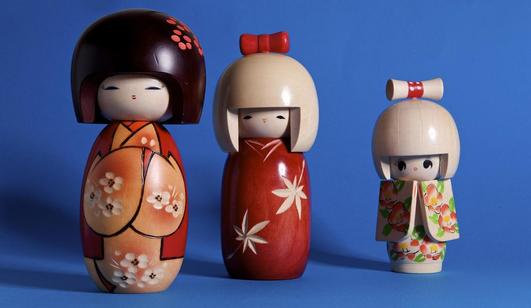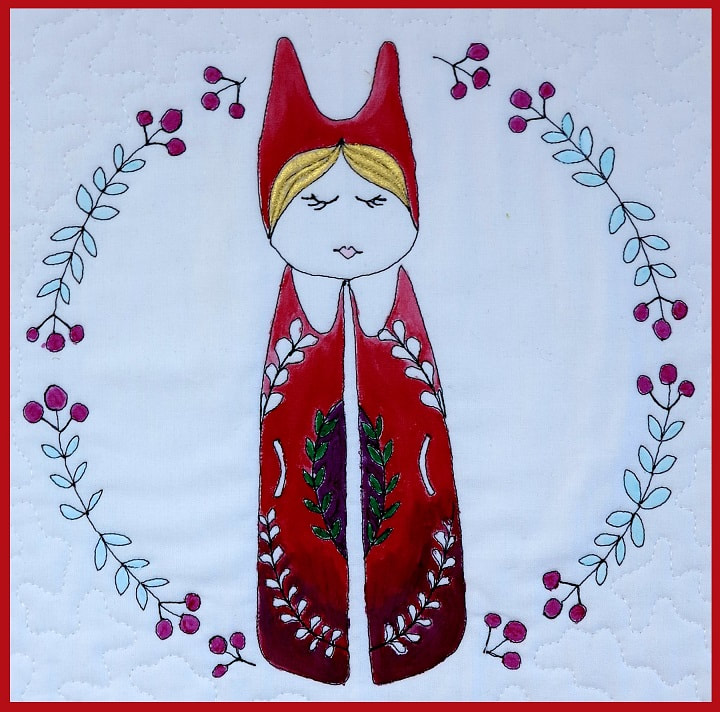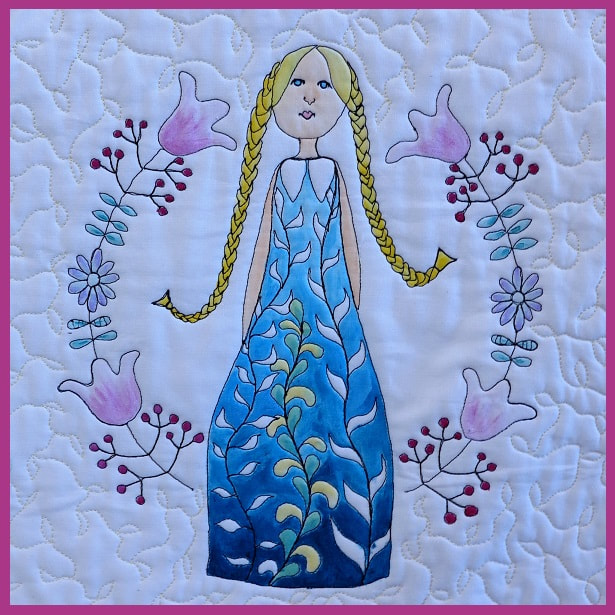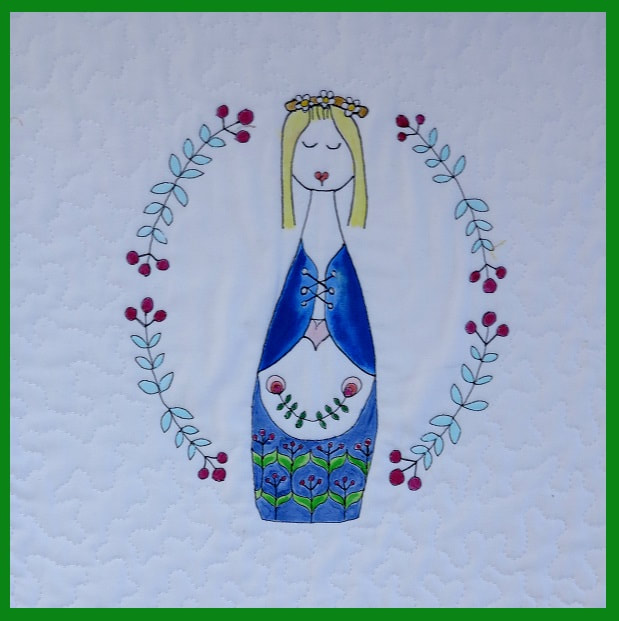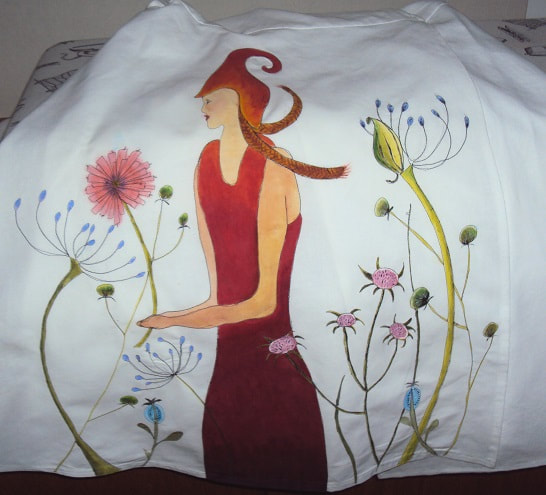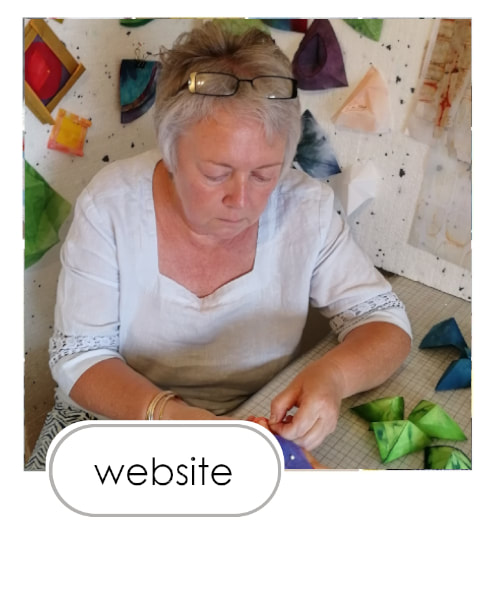|
I can't remember the last time I made a bed quilt; it has to be at least 5 years, probably longer. So, when I decided to make this one I came to it fresh - and enjoyed every minute of it!
It is a single bed size, so not too hard and made using the 'quilt-as-you-go' method, which meant that the intense free motion quilting I used on each of the panels was easy to handle on my small domestic Singer sewing machine. The quilt is currently hanging at Midsomer Quilting in Somerset, UK, and will be there until May 19th when I will be teaching how to make these pretty free motion quilted blocks. I designed 10 dolls and a very special horse for the workshop. The dolls are based on traditional painted wooden dolls from Russia, Japan and Scandinavia. The idea for the first doll came from the annual Midsomer Quilting 12 x 12 challenge in 2017, entitled 'Where in the World?' After some thought I decided to make a Russian Matryoshka Doll, and if you went to the exhibition you might recognise her.
These Russian dolls are an unmistakable symbol of Russian character, culture and country, an emotional feeling summarised as 'Russian Soul'. As I was researched the history of these elaborately decorated dolls I discovered a lot about similar dolls from other countries, and I was surprised to discover that the tradition of carving these so called 'Matryoshka' dolls (often mistakenly referred to as 'Babushka' - dolls) is not quite as old as I thought.
The first nesting Russian doll set was carved 1890 and has been atributed to a man named Vasily Zvyozdochkinn who made a set using a design by Sergey Malyutin, a folk craft painter. Traditionally the hollow outermost doll in the set is a maternal woman in traditional dress, known as a sarafan. Inside her hollow interior are a succession of smaller and smaller hollow dolls which can be male or female and the smallest, innermost doll is typically a baby turned from a single piece of wood.
Much of the artistry of these beautiful dolls is seen in their painting. Long dark winters are the perfect time for farmers and other artisans to spend time creating beautifully ornate masterpieces. Their decoration often follows a theme; fairy tale characters and regional traditional costume are popular. The name Matryoshka, written in Cyrillic as матрёшка, translates literally as 'little matron', and is a diminutive form of the Russian first name 'Matryona' or 'Matriosha' (Матрёна). This name is very popular in rural parts and is associated with the matriarchs of a big Russian family, having its origins in the the word mother (mama). I was interested to discover that although in the west we frequently call them 'Babushka' or Grandmother dolls, this is actually incorrect - they are not grandmothers at all! For people of Slavic origin Matryoshka is a symbol of motherhood and the fertility of nature, which why the traditional dolls take the form of a curvy, female shape, expressing the ancient symbol of motherhood. Some say that in ancient Russian tradition dolls were made without painted faces and did not represent living persons because it was believed that evil spirits could settle inside it. Others say that Matryoshka dolls were given to newborns to wish them a long and prosperous life - something that echoes with similar dolls in other cultures.
Photo credit: public domain: Doll carved by Zvezdochkin, painted by Malyutin - Sergiev Posad Museum of Toys, Russia, https://commons.wikimedia.org/w/index.php?curid=5051554
Ten years after the first Russian Matryoshka was created, the doll was presented to an international audience at the Exposition Universelle (World’s Fair) in Paris, where it won a bronze medal. The doll was a hit, quickly gaining popularity, and soon began production in multiple regions in Russia. By the 1930s, the dolls were being factory produced and shipped around the world.
Another more ancient nesting doll set, very likely to have influenced the creation of these Russian dolls, came from Japan. It is believed that the forerunner of the Matryoshka was brought from the Island of Honshu, Japan’s main island. Japanese wooden dolls representing Shichi-fuku-jin, the Seven Gods of Fortune are thought to have inspired Vasily Zvyozdochkinn. This ancient Japanese set of dolls has the largest outer doll taking the form of Fukuoka, a kindly, old, pot bellied Buddhist monk who symbolised happiness and longevity . Inside were 6 further dolls. Each of the dolls took the form of one of the 7 lucky gods from Japanese mythology.
Even older still are traditional Japanese Kokeshi dolls, originaing from north easern Japan. There are 11 traditional styles and are thought to have originated in the 1600's as souveniers for those visiting the spas in this part of Japan. Next are the 'lucky' Daruma dolls modelled after Bodhidharma, the founder of the Zen tradition of Buddhism. These dolls, though typically red and depicting a bearded man (Dharma), vary in color and design depending on region and artist. Though considered a toy by some, Daruma has a design that is rich in symbolism and is regarded more as a talisman of good luck to the Japanese.
A modern twist on these Japanese dolls is the 'Creative Kokeshi Dolll'. are probably more popular in the west. They developed as an art form since the 2nd World War and retain the limbless kokeshi characteristic. However, they are more contemporary in their design with more shapely bodies, added features such as hair, as well as colourful exquisitely patterned kimono. Creative kokeshi are 'created' by artists, and have features and styles unique to their own particular artist or creator. The majority of creative kokeshi are made in Gunma prefecture. These are the dolls that started my new series of doodles that resulted in the Doodle doll quilt. But of all the dolls in thie mini series, I think the Skandinavian inspired dolls are my favourite. Here are 3 of them. At the workshop we will be making square panels similar to those above, created by 'drawing' the design onto plain white fabric just using black thread. Once the design is stitched we then fill it with free motion quilting stitch and finally use fabric paints to colour them. Depending on how fast you work it is possible to complete 3 of these panels during the day. The panels can be used in lots of ways - to create a bed runner or a larger quilt, as a panel on a bag, as a wall hanging - or even stitched onto clothing.
Of course, you don't need to go to a workshop to create you own doodles. On paper or just draw an outline and start to fill it with repeated shapes. Once you have your design, set your sewing machine for free motion quilting and 'draw' your design with stitched thread. I paint my finished designs with fabric paint, but they also look very striking just left in black and white.
Why not have a go? If you are interested in coming to the workshop you can contact De at Midsomer Quilting https:midsomerq.com/. You can also see more on my website by clicking the button below Thanks for reading.
|
|
